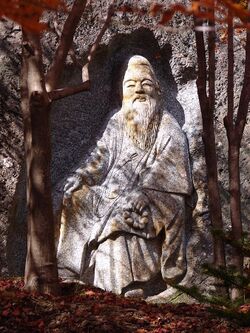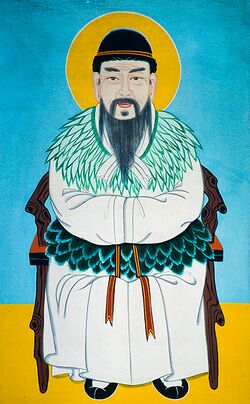Religion:Haneullim
Haneullim or Haneulnim (하늘님 "Heavenly Lord"/"Lord of Heaven"), also spelled Hanunim/Haneunim (하느님), Hanalnim (하날님), Hanulnim (하눌님), or Hananim (하나님 "One Lord"), birth name Hwanin (환인/ Hanja: 桓仁 or 桓因), also called Sangje (상제/ Hanja: 上帝, "Highest Deity"), Sangjenim (상제님/ mixed script: 上帝님, "Highest Divine Lord"), or Cheonju (천주/ Hanja: 天主, "Heavenly Lord"/"Lord of Heaven"), or known simply as Haneul (하늘 "Heaven"), Cheon (천/ Hanja: 天, "Heaven", in Sino-Korean), Cheonje (천제/ Hanja: 天帝, "Heavenly Emperor"/"Emperor of Heaven", in Sino-Korean), or Cheon-sin / Cheon-shin (천신/ Hanja: 天神, "God of Heaven"),[1] is the sky God of Cheondoism and Jeungsanism.[1] In the more Buddhist-aligned parts of these religions, he is identified with Indra. In the more Taoist-aligned parts of these religions, he is also known as Okhwang Sangje (Hangul: 옥황상제 / Hanja: 玉皇上帝, "Highest Deity the Jade Emperor").
Dangun myth
Dangun is traditionally considered to be the grandson of Hwanin, the "Heavenly King", and founder of the Korean nation.[2] Myths similar to that of Dangun are found in Ainu[3] and Siberian cultures.[4]
The myth starts with prince Hwanung ("Heavenly Prince"), son of Hwanin. The prince asked his father to grant him governance over Korea.[5] Hwanin accepted, and Hwanung was sent to Earth bearing three Heavenly Seals and accompanied by three thousand followers.[5] The prince arrived under the Sindansu/ Shindansu (신단수/ Hanja: 神檀樹, "Holy Tree of Sandalwood")[6] on the holy mountain, where he founded his holy city.[5]
At the time of his reign, Ungnyeo or Ungnye (웅녀, 熊女)[6]—who was a bear—and a tiger were living in a cave near the holy city, praying earnestly that their wish to become part of humankind might be fulfilled.[5] Ungnyeo patiently endured weariness and hunger, and after twenty-one days she was transformed into a woman, while the tiger ran away for it could not tolerate the effort.[5] The woman Ungnyeo was overjoyed, and visiting the sandalwood city she prayed that she might become the mother of a child.[5]
Ungnye's wish was fulfilled, so that she became the queen and gave birth to a prince who was given the royal name of Dangun, the "Sandalwood King".[5] Dangun reigned as the first human king of Korea, giving to his kingdom the name of Joseon, "Land of the Morning Calm", in 2333 BC.[5]
According to some scholars, the name Dangun is related to the Turko-Mongol Tengri ("Heaven"),[7] while the bear is a symbol of the Big Dipper (i.e. Ursa Major), itself a symbol of the supreme God in many Eurasian cultures, including Chinese theological thought.[8] Later in the myth, Dangun becomes the Sansin, the "Mountain God" (metaphorically of civilising growth, prosperity).[9]
Kingdom of Hwanin
In the Hwandan Gogi (환단고기/ Hanja: 桓檀古記), a supposed 20th century compilation of older historical works that is regarded by many to be a forgery, described Gojoseon to have existed and formed in Hwan-guk (환국/ Hanja: 桓國, "Kingdom of Hwan") and Baedal-guk (배달국/ Hanja: 倍達國, "Kingdom of Baedal": later known as Sinsi 신시/ Hanja: 神市, "City of the Gods"). It is said that both nations were ruled by Hwan-in and Hwan-ung, each spanning from 7 rulers and 18 rulers respectively.
Establishment of the Nation
According to the pseudo-historic document Hwandan Gogi (환단고기/ Hanja: 桓檀古記), Hwan-in transformed himself from the sky of Sabaek-nyeok/ Sabaek-ryeok (사백력) to become a god, and with him, 800 young men and women descended from the sky to the eastern land of the shallow sea (천해/ Hanja: 淺海), which is the land of Heuk-su (흑수/ Hanja: 黑水, "Black Water") and Baek-san (백산/ Hanja: 白山, "White Snow-capped Mountain"). Some claims the area of Sabaek-nyeok/ Sabaek-ryeok is Siberia (in spite of the similarity of prior archaic pronunciation), and the shallow sea is Lake Baikal.
The 12 Federations
According to Hwandan Gogi (환단고기/ Hanja: 桓檀古記), apart the Kingdom of Hwan (환국/ Hanja: 桓國), the nation is a federal state based on a nomadic culture composed each of the 11 countries:
1) Kingdom of Biri (비리국/ Hanja: 卑離國),
2) Kingdom of Yang-un (양운국/ Hanja: 養雲國),
3) Kingdom of Gumak-han (구막한국/ Hanja: 寇莫汗國),
4) Kingdom of Gudacheon (구다천국/ Hanja: 句茶川國),
5) Kingdom of Il-gun (일군국/ Hanja: 一群國),
6) Kingdom of Uru (우루국/ Hanja: 虞婁國) or either the Kingdom of Pilna (필나국/ Hanja: 畢那國),
7) Kingdom of Gaek-hyeon-han (객현한국/ Hanja: 客賢汗國),
8) Kingdom of Gumo-aek (구모액국/ Hanja: 句牟額國),
9) Kingdom of Mae-gu-yeo (매구여국/ Hanja: 賣句餘國) or either the Kingdom of Jikkuda (직구다국/ Hanja: 稷臼多國),
10) Kingdom of Sanapa/ Sanaba (사납아국/ Hanja: 斯納阿國),
11) Kingdom of Seonbi/ Seombi (선비국/ Hanja: 鮮裨國).
Its territory is so vast that it is said to be 50,000 li (around 25,000,000 metres or 25,000 kilometres) from north and south and 20,000 li (10,000,000 metres or 10,000 kilometres) from east and west on record.
Dynasty of Hwanin
According to the pseudo-historic literature Hwandan Gogi (환단고기/ Hanja: 桓檀古記), the Kingdom of Hwan (환국/ Hanja: 桓國), the period lasted for either 3,301 years to 63,182 years during this dynasty of kings, seven in total.
The following rulers of the dynasty is dominantly ancient Korean in nature:
| Annal/ Generation | King Name in Hanja | King Name(s) in Hangul | Title (descendants bearing the suffix: 환인 Hwan-in) | Transliterated Name
(/ = variants in pronunciation) |
Remarks |
|---|---|---|---|---|---|
| 1 | 安巴堅 | 안파견 | 안파견 환인 | Anpa-gyeon/ Ampa-gyeon Hwan-in | |
| 2 | 赫胥 | 혁서 | 혁서 환인 | Hyeok-seo Hwan-in | |
| 3 | 古是利 | 고시리 | 고시리 환인 | Goshiri Hwan-in | |
| 4 | 朱于襄 | 주우양 | 주우양 환인 | Ju-u-yang Hwan-in | |
| 5 | 釋提壬 | 석제임 | 석제임 환인 | Seok-je-im Hwan-in | |
| 6 | 邱乙利 | 구을리 | 구을리 환인 | Gu-eulli Hwan-in | |
| 7 | 智爲利 | 지위리 | 지위리 환인 | Jiwiri Hwan-in | also known as Hwan-in (환인; 桓仁), father of Hwan-ung (桓雄) |
See also
Counterparts of Haneullim in other Asian cultures
- Amenominakanushi, the Japanese counterpart
- Jade Emperor, the Chinese counterpart
- Para Brahman, the Hindu counterpart
- Śakra, the Buddhist counterpart
- Tengri, the Turko-Mongolian counterpart
- Thagyamin, the Burmese Buddhist representation of Śakra, a counterpart of the Jade Emperor
- Yahweh or Jehovah (referred as Allah ("the god") in Arabic), the Abrahamic counterpart
- Yuanshi Tianzun, the Taoist counterpart
- Ông Trời, the Vietnamese counterpart
References
- ↑ 1.0 1.1 Hong (2009), p. 39.
- ↑ Lee (1981), p. 13.
- ↑ Lee (1981), p. 20.
- ↑ Lee (1981), p. 21.
- ↑ 5.0 5.1 5.2 5.3 5.4 5.5 5.6 5.7 Lee (1981), p. 14.
- ↑ 6.0 6.1 Lee (2010s), pp. 10–13.
- ↑ Lee (1981), pp. 17–18.
- ↑ Didier (2009), passim but especially Vol. I, pp. 143, 154.
- ↑ Lee (1981), pp. 16–18.
Sources
- Didier, John C. (2009). "In and Outside the Square: The Sky and the Power of Belief in Ancient China and the World, c. 4500 BC – AD 200". Sino-Platonic Papers (Victor H. Mair) (192). Volume I: The Ancient Eurasian World and the Celestial Pivot, Volume II: Representations and Identities of High Powers in Neolithic and Bronze China, Volume III: Terrestrial and Celestial Transformations in Zhou and Early-Imperial China.
- Lee, Chi-ran (2010s). "The Emergence of National Religions in Korea". http://manak.org.in/wp-content/uploads/pdf-manak/The%20Emergence%20of%20National%20Religions%20in%20Korea.pdf.
- Lee, Jung Young (1981). Korean Shamanistic Rituals. Mouton De Gruyter. ISBN 9027933782.
- Hong, Sung-wook (2009). Naming God in Korea. Wipf & Stock. ISBN 978-1606086261.
- http://www.kikigengo.jp/jeju/doku.php?id=en:kindred:4370_4449_4354_4467_4527_4354_4469_4535



